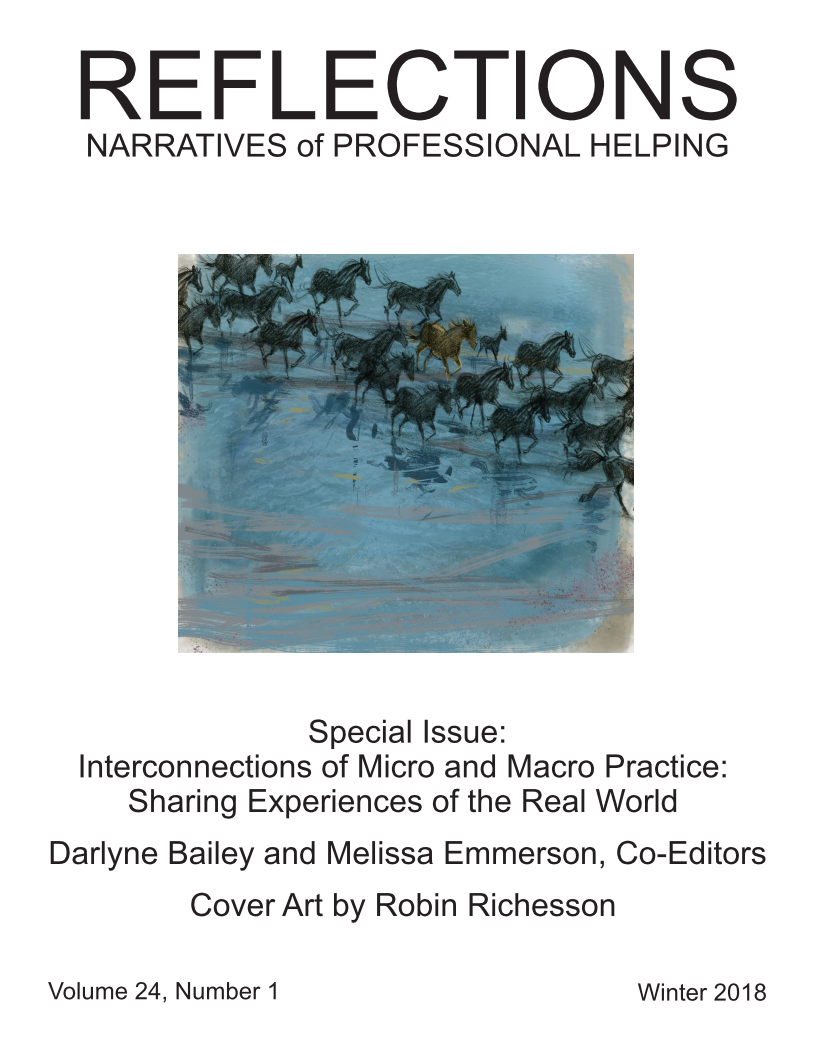Macro Practice in a Micro World: The Story of Youth Futures
Keywords:
macro practice, reflections, program building, Reflections, teaching, teamworkAbstract
The dichotomy of micro and macro practice is one that many social work students struggle with, especially when so many social workers just want to become therapists. My own experience in moving between the two worlds involved skepticism towards macro practice while training to be a therapist, then moving on to the world of academia where macro practice seemed to gain more value, then working in macro practice for a few years, and then trying to convince other students of the value of macro practice once returning to academia. One semester, a talented student taught me that macro practice was still alive and well in social work, and that macro was not just a part of the social work identity, but a fundamental part of what social workers do every day. She did this by creating a homeless youth shelter with the help of her cohort during one fateful fall semester.
Downloads
Published
How to Cite
Issue
Section
License
REFLECTIONS:
NARRATIVES OF PROFESSIONAL HELPING
SALEM STATE UNIVERSITY, PUBLISHER
PUBLICATION AGREEMENT
1. COPYRIGHT: If the manuscript you submit to this site (the “Manuscript”) is selected for publication in Reflections, the author(s) of the Manuscript hereby agree to transfer copyright of the Manuscript to Salem State University, including full and exclusive rights to reproduce the Manuscript in all media now known or later developed, including but not limited to electronic databases and microfilm, and in anthologies of any kind.
2. AUTHOR RE-USES OF MANUSCRIPT: As a professional courtesy, the author(s) retains the right to reprint the Manuscript again after publication in Reflections, in any work the author(s) is sole author, or in any edited work for which the author(s) is senior editor, though the author(s) is required to cite the Manuscript as a prior publication in “Reflections: Narratives of Professional Helping.” No further permission is necessary in writing from SSU, nor will SSU require fees of any kind for this reprinting. This statement is intended to provide a copyright release for the purposes set forth in this Section 2, and a photocopy of this Publication Agreement may be used when another publisher requires a written release.
3. READER RE-USES OF MANUSCRIPT: The author(s) acknowledge that registered readers of Reflections and others with access to the Manuscript may use the Manuscript consistent with applicable law including, but not limited to Fair Use under 17 U.S.C. § 107.
4. AUTHOR WARRANTIES: The author(s) represent(s) and warrant(s):
a.) that the Manuscript is the author's (authors') own work;
b.) that the Manuscript has been submitted only to this journal and that it has not been previously published;
c.) that the Manuscript contains no libelous or unlawful statements and does not infringe upon the civil rights of others;
d.) that the author(s) are not infringing upon anyone else’s copyright.
e.) that the author(s) are responsible for any individual or organizational names that are mentioned in the Manuscript, as SSU disclaims responsibility for references to individuals, organizations, facts, and opinions presented by the published author(s) in the Manuscript.
f.) That the author(s) have taken care to ensure that the Manuscript does not contain any identifiable information about clients or patients except as pursuant to appropriate permissions and forms of informed consent as provided for in all relevant laws and codes of ethics.
g.) That the Manuscript in no way violates any individual’s privacy rights.
The author(s) agree that if there is a breach of any of the above representations and warranties that the author(s) will indemnify SSU, including the publisher and editor of Reflections, and hold them harmless.
5. AUTHOR RETENTION OF PATENTS: The author(s) may have, within the Manuscript, descriptions of the author's (authors') own proprietary patents. Nothing herein shall be construed as a transfer of any proprietary right in such patents. Accordingly, the author(s) retains all proprietary rights in any such patents described in the Manuscript, but such reservation in rights does not include ownership of the Manuscript, and SSU shall retain full and exclusive rights to the Manuscript as set forth herein.
6. NOTE FOR U.S. GOVERNMENT EMPLOYEES: Any Manuscript authored by a U.S. government employee(s) as part of the employee's official duties, must be noted with your submission.
7. JOINT WORKS: Any Manuscript written by two or more authors with the intention that the Manuscript will be merged into one inseparable or interdependent parts of a unitary whole are considered a “Joint Work” under § 101 of the U.S. Copyright Act. This Agreement must be signed by all contributing authors to any Joint Work.
8. “WORK FOR HIRE” AUTHORS: If the Manuscript was written by an author(s) who was hired by another person or company to do so, the manuscript is considered a “Work Made for Hire” under § 101 of the U.S. Copyright Act. This Agreement must be signed by the “employer” who hired the author(s), as well as the author(s).
9. NO AMENDMENTS: This form is not valid if the author(s) add(s) any additional constraints and amendments. Please submit the article elsewhere for publication if the author(s) do not sign the form without alteration.

